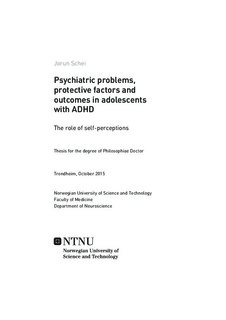| dc.contributor.author | Schei, Jorun | |
| dc.date.accessioned | 2015-11-19T11:37:14Z | |
| dc.date.available | 2015-11-19T11:37:14Z | |
| dc.date.issued | 2015 | |
| dc.identifier.isbn | 978-82-326-1181-2 | |
| dc.identifier.issn | 1503-8181 | |
| dc.identifier.uri | http://hdl.handle.net/11250/2364790 | |
| dc.description.abstract | ADHD is a common, neurodevelopmental disorder characterized by symptoms of inattention, hyperactivity, and impulsivity which affect functioning in academic, social, and family contexts. Its clinical presentation evolves across the lifespan, and the developmental course largely determines the disorder’s impact on everyday functioning. Coexisting problems or disorders are common across development, and worsen the outcomes. Adolescents with ADHD and co-existing emotional and conduct problems have increased risk of psychiatric disorders, functional impairment and QoL. Although ADHD is considered a strongly hereditary disorder, environmental factors may also be important risk factors for the development and course of this condition. Protective factors are thought to promote resilience, and include both individual and environmental factors. Risk and protective factors important for outcomes among adolescents with ADHD should be investigated.
The main objective of this thesis was to assess factors that may be of importance in achieving better outcomes in adolescents with ADHD.
In the first study we assessed the adolescents’ perceptions of family functioning and QoL according to level of coexisting emotional and conduct problems. We added parent reports to compare with the self-report, and included perspectives of both informant. To investigate these aims, we used a sample obtained from a cross-sectional survey of clinical adolescents with ADHD, aged 13-18 years. The sample of 194 adolescent with ADHD were divided into four groups; 1. Without additional emotional and conduct problems; 2. With additional emotional problems; 3. With additional conduct problems; 4. With additional emotional and conduct problems. The findings showed that adolescents with both emotional and conduct problems reported lower QoL and family functioning. On the other hand, parents reported a significant impact of coexisting problems on adolescents’ QoL, but not on family functioning. The findings of the study suggest that the self-perceptions of adolescents with ADHD generate useful information that may help to optimize clinical assessment.
In the second study we assessed the mediating and moderating effects of personal and environmental protective factors on the relationship between coexisting emotional and conduct problems and QoL. Individual competencies, which include self-esteem, structured style, and social competence, were the strongest mediator between coexisting emotional problems and QoL among adolescents with ADHD, including those who were prescribed psychostimulants. Social resources mediated the relationship between conduct problems and QoL. These findings indicate that assessment of protective factors, in addition to risk factors, may identify potential treatment goals.
In the third study, using a longitudinal design, we investigated whether the personal protective factors; self-esteem, structured style and social competence, were predictors of more favorable outcomes. Outcomes were psychosocial functioning, anxiety, depression and ADHD diagnoses three years later. Better self-esteem in adolescence was a predictor of better psychosocial functioning in young adulthood. A more structured style and better social competence were also associated with this outcome. Furthermore, better self-esteem in adolescence was associated with fewer depressive disorders, while social competence in adolescence was associated with fewer anxiety disorders in young adulthood. Further knowledge of protective factors might be useful in the development of support and clinical interventions for ADHD patients in the transition period from adolescence to emerging adulthood. | nb_NO |
| dc.language.iso | eng | nb_NO |
| dc.publisher | NTNU | nb_NO |
| dc.relation.ispartofseries | Doctoral thesis at NTNU;2015:262 | |
| dc.relation.haspart | Paper 1: Schei, Jorun; Jozefiak, Thomas; Nøvik, Torunn Stene; Lydersen, Stian; Indredavik, Marit Sæbø. The Impact of Coexisting Emotional and Conduct Problems on Family Functioning and Quality of Life Among Adolescents With ADHD. Journal of Attention Disorders 2013. Copyright © Reprinted by permission of SAGE Publicationshttp://doi.org/10.1177/1087054713507976 | |
| dc.relation.haspart | Paper 2: Schei, Jorun; Nøvik, Torunn Stene; Thomsen, Per Hove; Indredavik, Marit Sæbø; Jozefiak, Thomas. Improved quality of life among adolescents with attention-deficit/hyperactivity disorder is mediated by protective factors: A cross sectional survey. BMC Psychiatry 2015 ;Volum 15.(108). This is an Open Access article distributed under the terms of the Creative Commons Attribution License (http://creativecommons.org/licenses/by/4.0). Published version available at http://doi.org/10.1186/s12888-015-0491-0 | |
| dc.relation.haspart | Paper 3: Schei, Jorun; Nøvik, Torunn Stene; Thomsen, Per Hove; Lydersen, Stian; Indredavik, Marit Sæbø; Jozefiak, Thomas. What Predicts a Good Adolescent to Adult Transition in ADHD? The Role of Self-Reported Resilience. Journal of Attention Disorders 2015. Published version available at http://doi.org/10.1177/1087054715604362 | |
| dc.title | Psychiatric problems, protective factors and outcomes in adolescents with ADHD: The role of self-perceptions | nb_NO |
| dc.type | Doctoral thesis | nb_NO |
| dc.subject.nsi | VDP::Medical disciplines: 700::Clinical medical disciplines: 750::Neurology: 752 | nb_NO |
